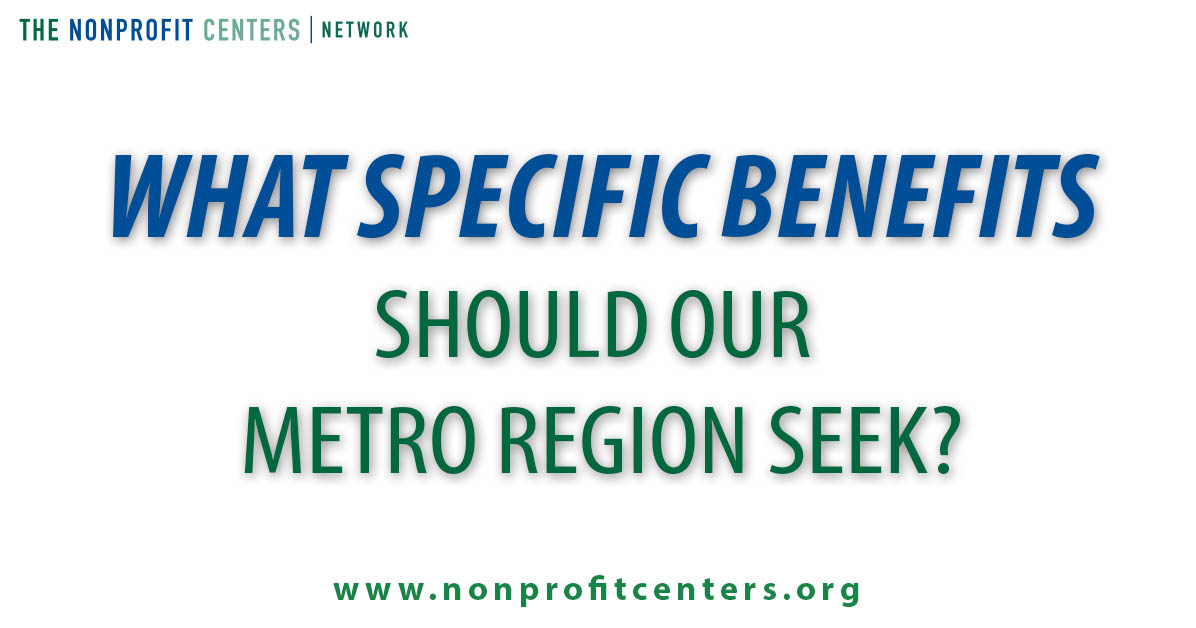As we worked to create a regional framework for Social Purpose Real Estate and non-profit colocation in St Louis we looked to the considerable experience of the 400+ non-profit centers in the U.S. and Canada that have preceded us. Our review of this experience suggests that we could gain six specific benefits (Table 1) from creating non-profit centers.
- Co-locating non-profits can enhance access to services by integrating services and putting them together in one shared location. The measurable outcomes might be increased use of services, easier access for constituents, and the establishment of a continuum of care.
- Co-locating non-profits can lower costs by sharing “back of house” supports such as accounting, human resources, and risk management. Further, reduced turnover and the benefit from being near other organizational directors and program administrators could contribute to the bottom line. The measurable outcomes could be increased operational strength and efficiency, lower costs, and better managed organizations. These benefits may be particularly valued by smaller non-profit organizations or by newer ones seeking to establish effective systems.
- Achieve a population-level outcome. This benefit is harder to measure and assure but the goal is to have a diverse group of actors implement a more comprehensive set of strategies to achieve a larger outcome than can be achieved alone. For example, this is the rationale behind the Chicago Literacy Alliance’s Literacenter” – the country’s first shared workspace devoted to literacy. Policy advocates, service providers, and marketing professionals from multiple agencies are located in one facility and could form cross-organizational teams to coordinate and implement complex strategies.
- Enhanced implementation of a shared business model. Co-locating non-profits hope to implement revenue generating activities with key partners. The measurable outcomes from this can include enhanced market access, increased revenue, and potential joint offerings to customers. This is an infrequent rationale for non-profit co-location. When it is the reason, it is used most often by non-profits who operate in a “business to business” market such as those that replicate evidence-based programs through partner non-profit agencies across the country.
- As has been demonstrated in the business sector, an innovation ecology can be nurtured through colocation when combined with other strategies. For non-profit organizations a social innovation ecology is desired, and this requires proximity, density, and organizational supports like those outlined above.
The final benefit does not accrue to the non-profit or even directly to those the organization serves. Rather, the final benefit is to the surrounding community in the form of economic development, historic preservation, strengthened neighborhoods, and improved living environments. In St Louis, the social sector makes up nearly 10% of the workforce. Further, millions of dollars are spent by the social sector on rent and real estate. Why not be more intentional in how we harness these financial resources to promote equitable community development?
Some Benefits of Non-Profit Co-location
| Primary Rationale | Measurable Benefits | Co-Locating Agencies Must Therefore: |
| 1. Improve Services |
|
|
| 2. Better Management |
|
|
| 3. Shared Outcomes |
|
|
| 4. Earn Revenue |
|
|
| 5. Stimulate Innovation |
|
|
| 6. Neighborhood Development |
|
|
Paul Evensen spoke at Sharing Innovation and is presenting a 3 part series of entries on his presentation topic: How Many Non-Profit Centers Do You Really Need? This is the second entry in the series.

